AHFS/Drugs.com Monograph Routes ofadministration Oral Molar mass 218.25 g/mol Density 1.229 g/cm³ | MedlinePlus a682077 ATC code N05BC01 (WHO) CAS ID 57-53-4 | |
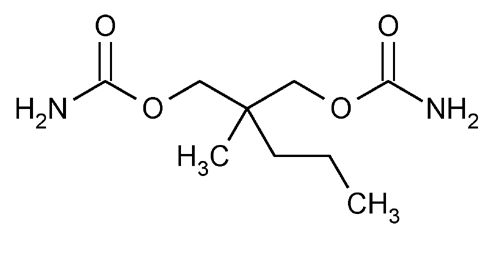 | ||
Trade names Miltown, Equanil, Meprospan, Amepromat, Quivet, Zirponand, and many others Pregnancycategory AU: CUS: D (Evidence of risk) | ||
Meprobamate — marketed as Miltown by Wallace Laboratories and Equanil by Wyeth, among others — is a carbamate derivative used as an anxiolytic drug. It was the best-selling minor tranquilizer for a time, but has largely been replaced by the benzodiazepines due to their wider therapeutic index (lower risk of toxicity at therapeutically prescribed doses) and lower incidence of serious side effects.
Contents

History
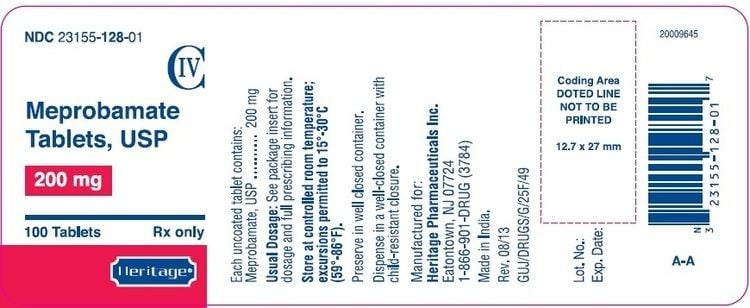
In the mid-1940s, Frank Milan Berger was working in a laboratory of a British drug company, looking for a preservative for penicillin, when he noticed that a compound called mephenesin had a sedative effect in laboratory rodents. Berger subsequently referred to this sedating or “tranquilizing” effect in a now-historic article, published by The British Journal of Pharmacology in 1946. However, there were three major drawbacks to the use of mephenesin as a tranquilizer: a very short duration of action, greater effect on the spinal cord than on the brain, and a weak activity. In May 1950, after moving to Carter Products in New Jersey, Berger and a chemist, Bernard John Ludwig, synthesized a chemically related tranquilizing compound, meprobamate, that was able to overcome these three drawbacks. Wallace Laboratories, a subsidiary of Carter Products, bought the license and named their new product "Miltown" after the borough of Milltown in New Jersey. Launched in 1955, it rapidly became the first blockbuster psychotropic drug in American history, becoming popular in Hollywood and gaining notoriety for its seemingly miraculous effects. It has since been marketed under more than 100 trade names, from Amepromat through Quivet to Zirpon.

A December 1955 study of 101 patients at the Mississippi State Hospital in Whitfield, Mississippi, found meprobamate useful in the alleviation of "mental symptoms." Three percent of the patients made a complete recovery, 29% were greatly improved, and 50% were somewhat better. Eighteen percent realized little change. Self-destructive patients became cooperative and calmer, and experienced a resumption of logical thinking. In 50% of the cases relaxation brought about more favorable sleep habits. Hydrotherapy and all types of shock treatment were halted. Meprobamate was found to help in the treatment of alcoholics by 1956. By 1957, over 36 million prescriptions had been filled for meprobamate in the US alone, a billion pills had been manufactured, and it accounted for fully a third of all prescriptions written. Berger, clinical director of Wallace Laboratories (who died on March 16, 2008, aged 94), described it as a relaxant of the central nervous system, whereas other tranquilizers suppressed it. A University of Michigan study found that meprobamate affected driving skills. Though patients reported being able to relax more easily, meprobamate did not completely alleviate their tense feelings. The disclosures came at a special scientific meeting at the Barbizon Plaza Hotel in New York City, at which Aldous Huxley addressed an evening session. He predicted the development of many chemicals "capable of changing the quality of human consciousness", in the next few years.
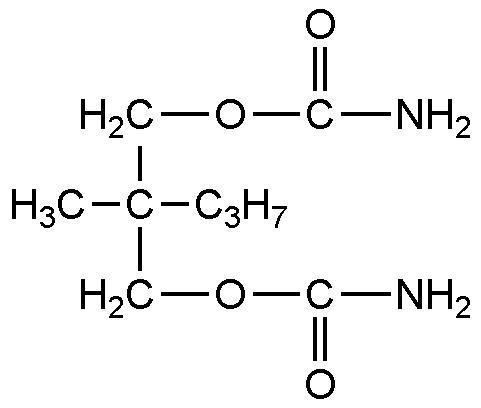
In January 1960, Carter Products, Inc. and American Home Products Corporation (which marketed meprobamate as Equanil) were charged with having conspired to monopolize the market in mild tranquilizers. It was revealed that the sale of meprobamate earned $40,000,000 for the defendants. Of this amount American Home Products accounted for approximately 2/3 and Carter about 1/3. The U.S. government sought an order mandating that Carter make its meprobamate patent available at no charge to any company desiring to use it.

In April 1965, meprobamate was removed from the list of tranquilizers when experts ruled that the drug was a sedative instead. The U.S. Pharmacopoeia published the ruling. At the same time the Medical Letter disclosed that meprobamate could be addictive at dosage levels not much above recommended. In December 1967, meprobamate was placed under abuse control amendments to the Food, Drug and Cosmetic Act. Records on production and distribution were required to be kept. Limits were placed on prescription duration and refills.
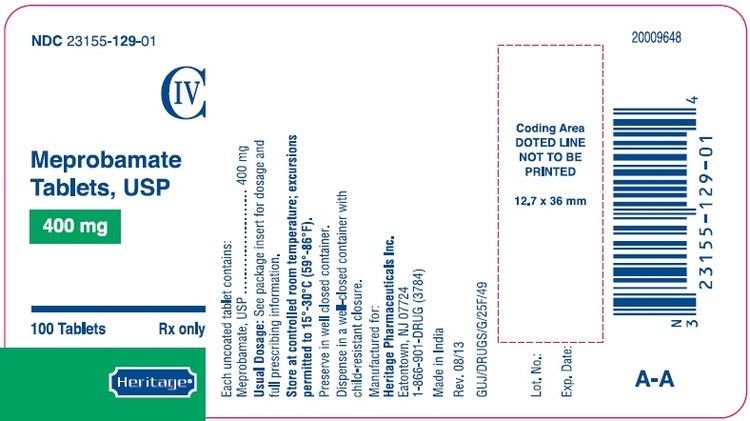
Production continued throughout the 1960s, but by 1970 meprobamate was listed as a controlled substance after it was discovered to cause physical and psychological dependence.

On January 19, 2012, the European Medicines Agency withdrew marketing authorization in the European Union for all medicines containing meprobamate, "due to serious side effects seen with the medicine." The Agency’s Committee for Medicinal Products for Human Use (CHMP) "concluded that the benefits of meprobamate do not outweigh its risks." In October 2013, Canada also withdrew marketing authorization.
Pharmacology

Although it was marketed as being safer, meprobamate has most of the pharmacological effects and dangers of the barbiturates and acts at the barbiturate binding site (though it is less sedating at effective doses). It is reported to have some anticonvulsant properties against absence seizures, but can exacerbate generalized tonic-clonic seizures.
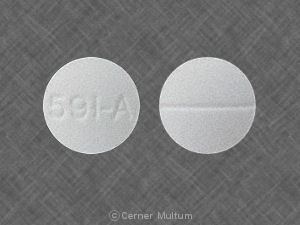
Meprobamate's mechanism of action is not completely known. It has been shown in animal studies to have effects at multiple sites in the central nervous system, including the thalamus and limbic system. Meprobamate binds to GABAA receptors which interrupts neuronal communication in the reticular formation and spinal cord, causing sedation and altered perception of pain. It has been shown that meprobamate has the ability to activate currents even in the absence of GABA. This relatively unique property makes meprobamate exceptionally dangerous when used in combination with other GABA-mediated drugs (including alcohol). It is also a potent adenosine reuptake inhibitor (AdoRI), which is most likely responsible for its lesser degree of sedation compared to barbiturates. Related drugs include carisoprodol and tybamate (prodrugs of meprobamate), felbamate, mebutamate, and methocarbamol.
Indications
Meprobamate is licensed for the short-term relief of anxiety, although it is not known whether the purported anti-anxiety effects of meprobamate are separable from its sedative effects. Its effectiveness as a selective agent for the treatment of anxiety has not been proven in humans, and is not used as often as the benzodiazepines for this purpose.

Meprobamate is available in 200 mg and 400 mg tablets for oral administration. Meprobamate is also a component of the combination drug Equagesic (discontinued in the UK in 2002) acting as a muscle relaxant.
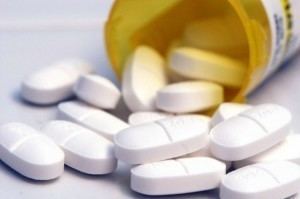
Meprobamate, like barbiturates, possesses an analgesic/anesthetic potential. It is also found as a component of the combination analgesic "Stopayne" capsules (along with paracetamol (acetaminophen), caffeine, and codeine phosphate).
Overdose
Symptoms of meprobamate overdose include: drowsiness, sluggishness, unresponsiveness, or coma; loss of muscle control; severe impairment or cessation of breathing; or shock. Death has been reported with ingestion of as little as 12 g of meprobamate and survival with as much as 40 g. In an overdose, meprobamate tablets may form a gastric bezoar, requiring physical removal of the undissolved mass of tablets through an endoscope; therefore, administration of activated charcoal should be considered even after 4 or more hours or if levels are rising.
Preparations which contain paracetamol may also induce severe liver toxicity resulting from paracetamol poisoning. The exact form of the preparation used should be identified immediately if possible, as patients who have also overdosed on paracetamol can reduce/avoid permanent liver damage with the administration of acetylcysteine.
Meprobamate overdosage is still a continuing problem.
Health issues
Meprobamate is a Schedule IV drug (US) (S5 in South Africa) under the Convention on Psychotropic Substances. With protracted use it can cause physical dependence and a potentially life-threatening abstinence syndrome similar to that of barbiturates and alcohol (delerium tremens). For this reason, discontinuation is often achieved through an extended regimen of slowly decreasing doses over a period of weeks, or even months. Alternatively, the patient may be switched to a longer-acting gabaergic agent such as diazepam (in a manner similar to the use of methadone therapy for opiate addiction) before attempting de-titration.
An acute cerebral edema caused by a reaction to Equagesic, a combination of aspirin and meprobamate, is believed to have caused the death of Bruce Lee.
"In the January 2008 issue of Drug Safety Update, a Stop press article announced the recent European review of carisoprodol for which the Committee for Medicinal Products for Human Use (CHMP) concluded that the risks of treatment outweigh the benefits. This review was triggered by concerns from the Norwegian Medical Agency that carisoprodol (converted to meprobamate after administration) was associated with increased risk of abuse, addiction, intoxication, and psychomotor impairment." February 2008.
European Medicines Agency recommended suspension of marketing authorisations for meprobamate-containing medicines in the European Union in January 2012.
Synthesis
Meprobamate, 2-methyl-2-propyl-1,3-propandiol dicarbamate is synthesized by the reaction of 2-methylvaleraldehyde with two molecules of formaldehyde and the subsequent transformation of the resulting 2-methyl-2-propylpropan-1,3-diol into the dicarbamate via successive reactions with phosgene and ammonia.
